Positive effects of Galileo side-alternating vibration in Cerebral Palsy
- Reduction of spasticity
- Improvement of muscle force and power
- Improved gait speed
- Improvement of mGMFM (modified gross motor function measure)
- Higher bone mass

J Diabetes Sci Technol. 2014 Jul;8(4):889-94. doi: 10.1177/1932296814536289. Epub 2014 May 21
Paula K. Johnson, MS; J. Brent Feland, PT, PhD; A. Wayne Johnson, PT, PhD; Gary W. Mack, PhD; Ulrike H. Mitchell, PT, PhD
Department of Exercise Sciences Brigham Young University, Provo, UT
Background: Vascular dysfunction due to hyperglycemia in individuals with diabetes is a
factor contributing to distal symmetric polyneuropathy (DSP). Reactive oxygen species (ROS)
reduce the bioavailability of nitric oxide (NO), a powerful vasodilator, resulting in reduced
circulation and nerve ischemia. Increases in blood NO concentrations and circulation have been
attributed to whole body vibration (WBV).
The purpose of this study was to the determine the effects of low frequency, low amplitude WBV on whole blood NO concentration and skin blood flow (SBF) in individuals with symptoms of DSP.
Research Design and Methods: Ten subjects with diabetes and impaired sensory
perception in the lower limbs participated in this cross-over study. Each submitted to two
treatment conditions, WBV and sham, with a one week washout period between. Blood draws
for NO analysis and Doppler laser image scans of SBF were performed before, immediately after and following a 5 minute recovery of each the treatments.
Results: Low frequency, low amplitude WBV vibration significantly increased skin blood
flow compared to the sham condition (F2,18=5.82, p=0.0115). Whole blood nitric oxide
concentrations did not differ between the WBV and sham condition immediately or 5 minutes
post-treatment (F2,18=1.88, p=0.1813)
Conclusions: These findings demonstrate that subjects with diabetes respond to whole
body vibration with increased skin blood flow compared to sham condition. The implication is
that WBV is a potential non-pharmacological therapy for neurovascular complications of
diabetes.
Chron Respir Dis, 2015; (): , PMID: 25904085 ![]()
Gloeckl R, Heinzelmann I, Kenn K
Department of Respiratory Medicine and Pulmonary Rehabilitation, Schoen Klinik Berchtesgadener Land, Schoenau am Koenigssee, Germany rainer.gloeckl@gmx.de.
In recent years, several studies have shown that whole body vibration training (WBVT) may be a beneficial training mode in a variety of chronic diseases and conditions such as osteoporosis, fibromyalgia, multiple sclerosis, or chronic low back pain. However, a systematic review on the effects of WBVT in patients with chronic obstructive pulmonary disease (COPD) has not been performed yet.
An extensive literature search was performed using various electronic databases (PubMed, Embase, LILACS, and PEDro). They were searched from inception until September 20, 2014, using key words like “COPD” and “whole body vibration training.” A total of 91 studies could be identified and were screened for relevance by two independent reviewers. Six studies were included in a qualitative analysis.
Trials studied either the effects of WBVT versus an inactive control group, versus sham WBVT, during an acute COPD exacerbation or as a modality on top of conventional endurance and strength training.
All randomized trials reported a significantly superior benefit on exercise capacity (6-minute walking distance) in favor of the WBVT group. Although there are only few studies available, there is some preliminary evidence that WBVT may be an effective exercise modality to improve functional exercise capacity in patients with COPD.
Lower-extremity muscle atrophy and fat infiltration after chronic spinal cord injury.
J Musculoskelet Neuronal Interact, 2015; 15(1): 32-41, PMID: 25730650
Moore CD, Craven BC, Thabane L, Laing AC, Frank-Wilson AW, Kontulainen SA, Papaioannou A, Adachi JD, Giangregorio LM
Brain and Spinal Cord Rehabilitation Program, Toronto Rehabilitation Institute, University Health Network.
Abstract
BACKGROUND: Atrophy and fatty-infiltration of lower-extremity muscle after spinal cord injury (SCI) predisposes individuals to metabolic disease and related mortality.
OBJECTIVES: To determine the magnitude of atrophy and fatty-infiltration of lower-extremity muscles and related factors in a group of individuals with chronic SCI and diverse impairment.
METHODS: Muscle cross-sectional area and density were calculated from peripheral quantitative computed tomography scans of the 66% site of the calf of 70 participants with chronic SCI [50 male, mean age 49 (standard deviation 12) years, C2-T12, AIS A-D] and matched controls. Regression models for muscle area and density were formed using 16 potential correlates selected a priori.
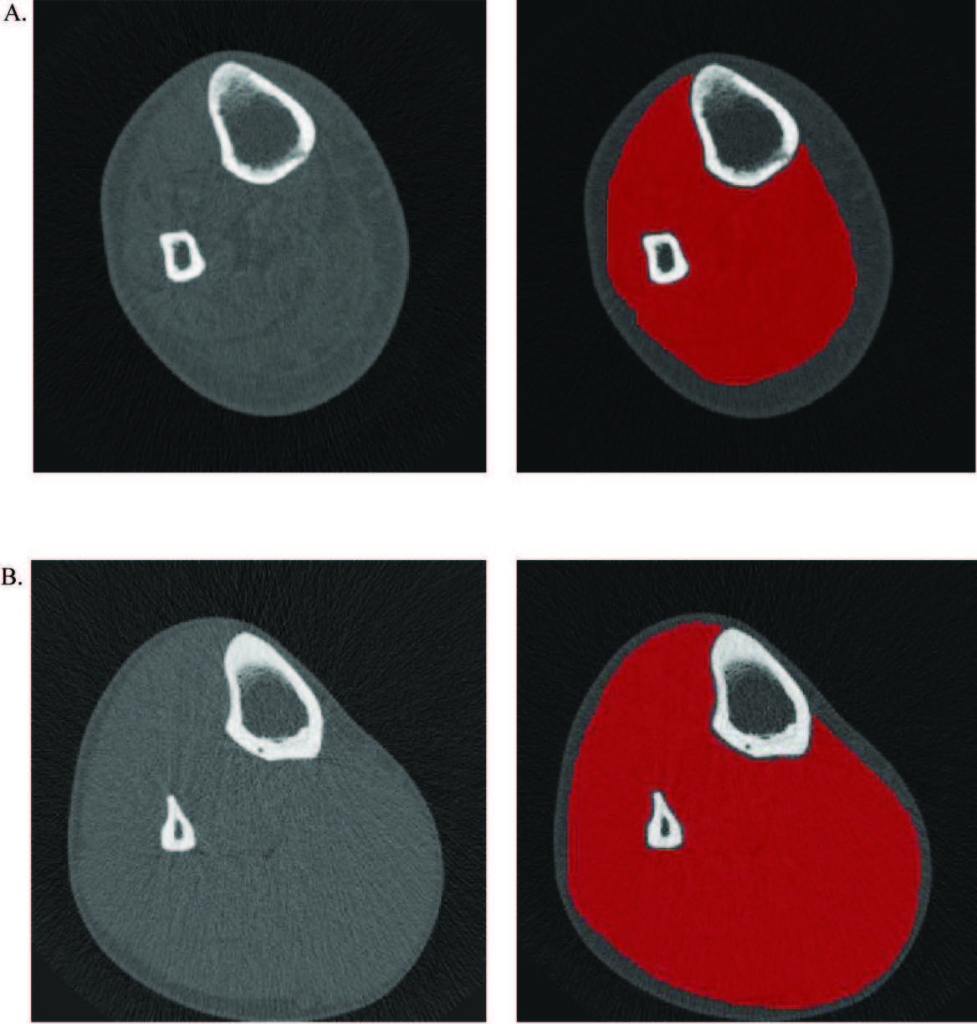
An illustration of watershed-guided muscle segmentation of the 66% site of the calf of a male with complete paraplegia (A) and corresponding able-bodied control (B).
RESULTS: Participants with motor-complete SCI had approximately 32% lower muscle area, and approximately 43% lower muscle density values relative to controls. Participants with motor-incomplete SCI had muscle area and density values that were both approximately 14% lower than controls. Body mass (+), tetraplegia (+), motor function (+), spasticity (+), vigorous physical activity (+), wheelchair use (-), age (-), and waist circumference (-) were associated with muscle size and/or density in best-fit regression models.
CONCLUSIONS: There are modifiable factors related to muscle size, body composition, and activity level that may offer therapeutic targets for preserving metabolic health after chronic SCI.
The first time 68-year-old Carmen Sandoval climbed on the whole-body vibration machine in The University of Texas at El Paso’s Stanley E. Fulton Biomechanics and Motor Behavior Laboratory, she wasn’t sure how standing on the machine while it oscillated for five minutes was going to help improve her physical fitness.
Two months later, Sandoval’s muscle strength and bone density have increased, and she feels lighter on her feet. That has helped her chase more fly balls while playing softball with Senior Moments, an El Paso women’s slow-pitch softball team.
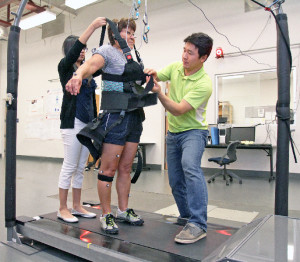
As part of the whole-body vibration study, Carmen Sandoval walks on a special treadmill, which simulates slipping by suddenly changing the moving direction of the belt. Participants are strapped into a harness to prevent injury. Photo by J.R. Hernandez / UTEP News Service
“It gives me more blood circulation in my legs,” Sandoval said. “I feel more energized and I don’t feel heavy on my legs.”
Sandoval is taking part in one of two studies by Feng Yang, Ph.D., an assistant professor in the Department of Kinesiology at UTEP, who is researching the impact of whole-body vibration training on adults 65 years and older and on people with multiple sclerosis, or MS.
In whole-body vibration therapy, a person stands on a vibration platform. As the machine vibrates, the transmission of mechanical vibrations and oscillations to the human body forces all muscles to contract and relax tens of times each second, and leads to physiological and neuromuscular changes that can reduce falls among individuals at greater fall risk.
In November, Yang received a $78,148 grant from The Retirement Research Foundation to investigate if whole-body vibration training can prevent real-life falls in Hispanic older adults. His co-principal investigators are Loretta Dillon, DPT, clinical associate professor in the Department of Physical Therapy, and Xiaogang Su, Ph.D., associate professor in the Department of Mathematical Sciences.
Yang, along with Dillon and Su, also were awarded a separate $43,297 pilot grant from the National Multiple Sclerosis Society to use the technique to study its effect on preventing falls in individuals with MS.
“Whole-body vibration is a relatively novel training approach which we can use to reduce the risk of falls for older adults or for people with movement disorders,” explained Yang, the lab’s director since 2013. “This vibration can increase muscle strength and improve the body balance and it can also improve the function in mobility, sensation, bone density and all those factors that are closely related to falls.”
The Centers for Disease Control and Prevention reports that falls are the leading cause of both fatal and nonfatal injuries among older adults, and the consequences of falls are very costly.
For his study, Yang developed an eight-week training program for 100 adults ages 65 years and older to investigate whether or not whole-body vibration training can reduce their risk of falling and if the training is still effective three months after they finish the program. Since June 2014, about 50 older adults have participated in the 18-month study.
Participants use the whole-body vibration machine for five minutes, three times a week for eight weeks.
To test if the training has improved their resistance to falls, participants walk on a special treadmill, which simulates a slipping sensation by suddenly changing the moving direction of the belt. Participants are strapped into a harness to prevent injury.
Thirty reflective markers are attached to their skin on different parts of the body, which allow their movements to be recorded using the lab’s eight-camera high-speed motion capture system. The captured motion data will be utilized to analyze the improvement in fall resistance skills resulting from the vibration training.
The goal is to see how a person regains balance after a slip without falling to the ground.
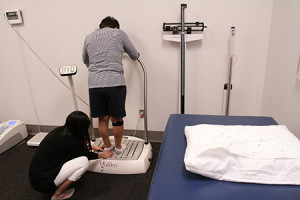
Carmen Sandoval stands on the whole body vibration machine in UTEP’s Biomechanics and Motor Behavior Laboratory. Feng Yang, kinesiology assistant professor, is studying the effects of whole-body vibration on adults 65 years and older and people with multiple sclerosis. Photo by J.R. Hernandez / UTEP News Service
“It (feels) like when we really stumble because we don’t know when we’re going to stumble,” Sandoval said after the treadmill stopped suddenly and she was jolted backward before regaining her composure.
Yang also evaluates the participants’ progress by measuring their muscle strength, bone density, sensation, range of motion, fear of falling, and functional mobility. All participants’ real-life fall incidences also are monitored.
Yang said the results of the study so far have been encouraging. Besides the significant improvements in all risk factors of falls among the participants, their slip-related falls on the treadmill and the fall incidences in everyday living have been reduced by about 70 percent and 30 percent, respectively.
He is currently recruiting 40 participants for his multiple sclerosis study. The National Multiple Sclerosis Foundation estimates that more than 400,000 people in the U.S. have MS. This project has particular significance for the El Paso region, which has been identified as a nationally-recognized cluster of MS by the society.
“We also want to prevent falls for patients with MS because their fall risk is even higher,” Yang said. “Their muscles are weak, their balance and sensation are impaired and MS also affects their mobility. All of those factors contribute to falls.”
Through whole-body vibration training, Yang hopes to develop a training paradigm that involves the least amount of physical activity for individuals with MS to reduce their risk of falls.
Yang is looking for participants with mild to moderate MS who have fallen at least once in the past six months for his study. Participants will take part in whole-body vibration training for five minutes a day, three days a week for four weeks.
Before the training begins, participants will be assessed to determine how many times they have fallen in the last six months. Their fall risk factors, including body balance, functional mobility, muscle strength, fear of falling and sensorimotor skills, also will be evaluated before and after the training to document any improvement.
Yang and his collaborators also are planning to apply vibration therapy to individuals with other movement dysfunctions, such as stroke and Parkinson’s disease. The long-term goal of their research is to develop cost-efficient yet effective community-based fall prevention training programs and to reduce the costs to individuals and the health care system resulting from falls among the elderly and populations with movement impairments.
Helping Yang achieve that goal are 10 research assistants from the undergraduate and graduate kinesiology programs at UTEP. They include: Chelsea Villa, Joshua Padilla, Westin Humble, Amy Lucero, Joe Anthony Rodriguez, Carlos Lopez, Maria Sanchez, JaeEun Kim, Jose Munoz and Edson Estrada.
In January 2014, Villa began working with Yang in the biomechanics lab as an undergraduate research assistant. She graduated from UTEP in December 2014 and plans to start the Doctor of Physical Therapy program in May.
From gathering medical histories, testing the participants and analyzing data, Villa said her experience working with Yang will help prepare her to become a better physical therapist.
“I know how important clinical-based research is when applied to the real world,” Villa said. “That’s the whole reason why research is done: to see what works and what doesn’t. Sometimes we think something does work and then we do the research and it turns out that it doesn’t. I know now what information is important to analyze and what information is not.”
To participate in either study, contact Yang at 915-747-8228 or 915-747-6010 or by email at fyang@utep.edu.
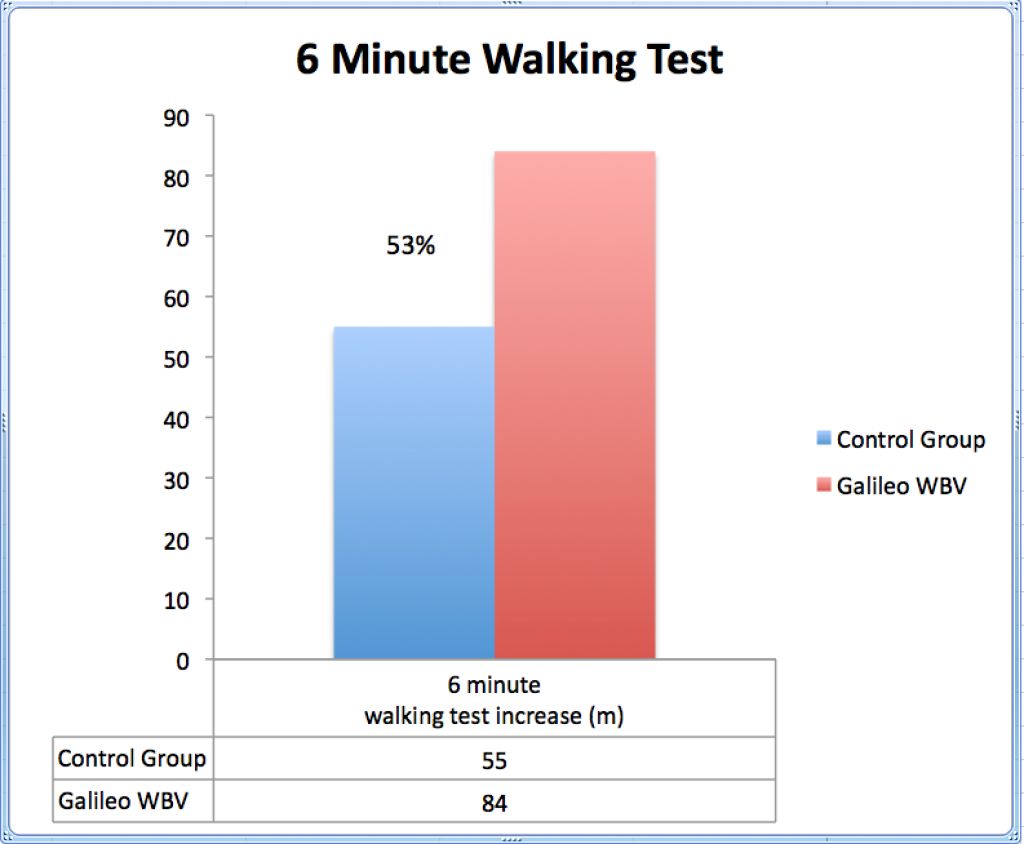
In a former study we could show that performing whole body vibration training (WBVT) in addition to endurance and strength training was superior in increasing exercise capacity in patients with severe chronic obstructive pulmonary disease (COPD). Thus, we now used this training regime in patients after lung transplantation (LTx) to investigate if there is also an additional benefit of WBVT in this special patient cohort.
Consecutively 83 LTx-patients (mean 10.7±12.8 weeks after LTx due to interstitial lung disease: n=51 and COPD: n=32, single-/double-LTx: n=28/55, age: 56±7ys, FEV1: 71±20% pred., 6-minute-walking-distance (6MWD) 368±113m) were enrolled in this randomized controlled trial. All patients underwent a 4-week inpatient pulmonary rehabilitation (PR) program including standardized endurance and strength training on 5 days per week. Additionally patients performed a dynamic and self-paced squat training (3 times per week for 4×2 minutes each). Patients were randomly assigned to perform squat training either on a WBVT platform (Galileo®, Novotec Medical, Germany) at a high frequency of 24 to 26 Hertz with a peak-to-peak displacement of 4 to 5 mm (WBVT-group) or on the floor (control group). Primary outcome parameter was the 6MWD. Further outcome parameters were peak quadriceps force (QF), peak work rate (PWR) and the 5-repetition chair-rise-test (5-CRT).
Seventy patients completed the study and were included in the final analysis (WBVT: n=34, control: n=36). The 6MWD improved significantly more in the WBVT-group compared to the control group (84±57m versus 55±47m, delta 29m, p=0.015 (95%CI 3.1 – 53.7m). Secondary outcome parameters also improved significantly but without any significant between-group difference (PWR: WBVT 17±11watt versus control 13±10watt, QF: WBVT 10.3±9.0% versus control 8.8±5.7%, 5-CRT: WBVT -5.1±4.7 sec versus control -3.8±6.1 sec). No training related adverse events did occur.
A complementary WBVT on top of conventional endurance and strength training seems to be superior in improving 6MWD in patients after LTx compared to endurance and strength training alone.
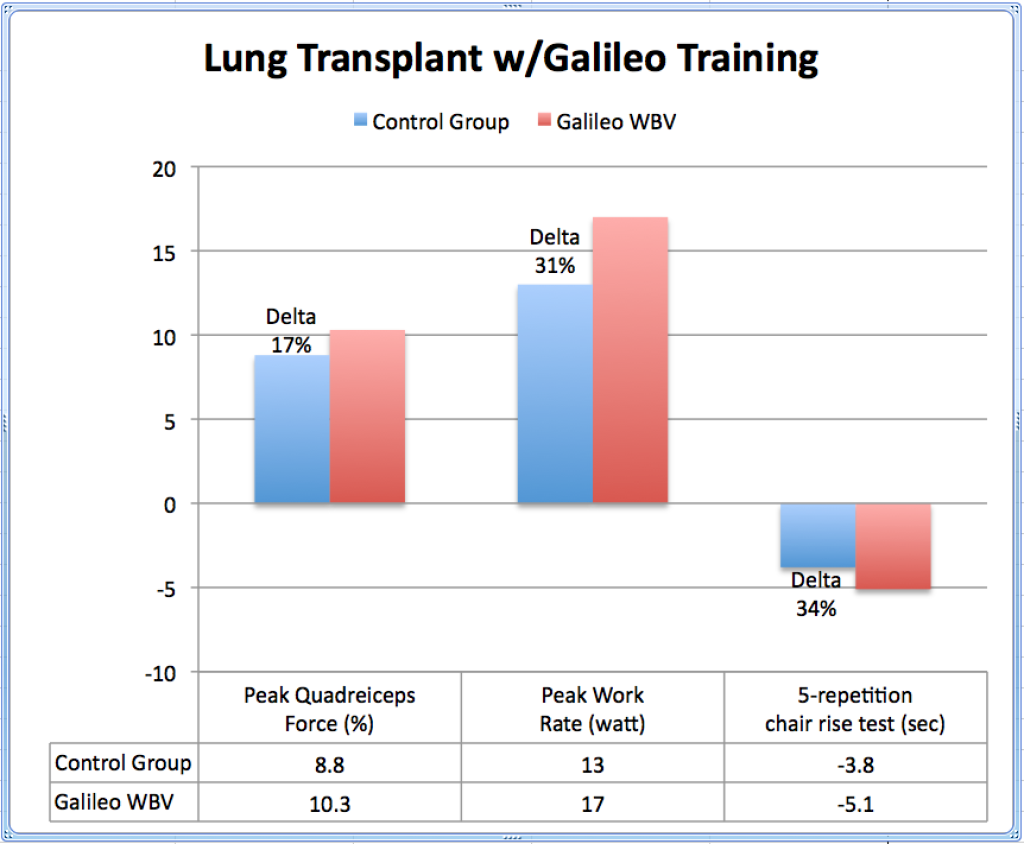
Respir Med. 2012 Jan;106(1):75-83. doi: 10.1016/j.rmed.2011.10.021. Epub 2011 Nov 21.
Gloeckl R, Heinzelmann I, Baeuerle S, Damm E, Schwedhelm AL, Diril M, Buhrow D, Jerrentrup A, Kenn K.
Source: Department of Respiratory Medicine, Schoen Klinik Hospital, Schoenau am Koenigssee, Germany. rainer.gloeckl@gmx.de
Abstract:
INTRODUCTION: To date endurance and strength training are established and evidence-based exercise methods in patients with chronic obstructive pulmonary disease (COPD). There is an unmet need for further research in new and complementary exercise modalities. Additional whole body vibration training during pulmonary rehabilitation may be such a new approach that has not yet been investigated in patients with COPD.
METHODS: Eighty-two patients (65 ± 9 yrs, FEV(1) pred. 38 ± 11%, female 51%) with COPD in GOLD stage III to IV assessed for a 3-week inpatient multidisciplinary rehabilitation program were on top randomly assigned to one of two intervention groups: (1) 3 × 3 min of bilateral dynamic squat exercises on a side-alternating vibration platform at 24-26 Hz three times per week (WBV) and (2) a control group (CON) with the same amount of exercise time without WBV.
RESULTS: Thirty-six patients completed the study in each group. The improvement in 6-min walking distance was significantly higher in the WBV-group when compared to the CON-group (WBV: 64 ± 59 m, CON: 37 ± 52 m with a between-group difference of 27 m [95% CI, 1-53], p = 0.046). The time required for a sit-to-stand test also decreased more markedly in the WBV-group than in the CON-group (WBV: -4.0 ± 4.8 s, CON: -2.0 ± 3.1 s with a between-group difference of -1.9 s [95% CI, -4.0 to 0.1], p = 0.067). Improvements in health-related quality of life were similar in both groups.
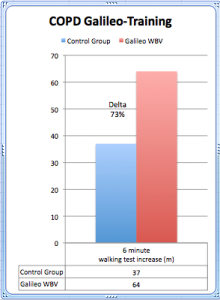
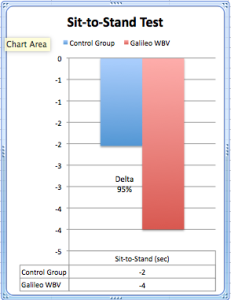
CONCLUSIONS: WBV training seems to be a promising new exercise modality for patients with COPD and may enhance the effects of a multidisciplinary rehabilitation program.
PMID: 22104540 Copyright © 2011 Elsevier Ltd. All rights reserved.
Institute of Sport and Sport Science, University of Freiburg, Schwarzwaldstraße 175, 79117 Freiburg, Germany. ramona.ritzmann@sport.uni-freiburg.de
This study aimed to assess the influence of different whole body vibration (WBV) determinants on the electromyographic (EMG) activity during WBV in order to identify those training conditions that cause highest neuromuscular responses and therefore provide optimal training conditions. In a randomized cross-over study, the EMG activity of six leg muscles was analyzed in 18 subjects with respect to the following determinants:
The results are:
In conclusion, large variations of the EMG activation could be observed across conditions. However, with an appropriate adjustment of specific WBV determinants, high EMG activations and therefore high activation intensities could be achieved in the selected muscles.
The combination of high vibration frequencies with additional load on the SV platform (Galileo) led to highest EMG activities. Regarding the body position, a knee flexion of 60° and forefoot stance appear to be beneficial for the knee extensors and the plantar flexors, respectively.
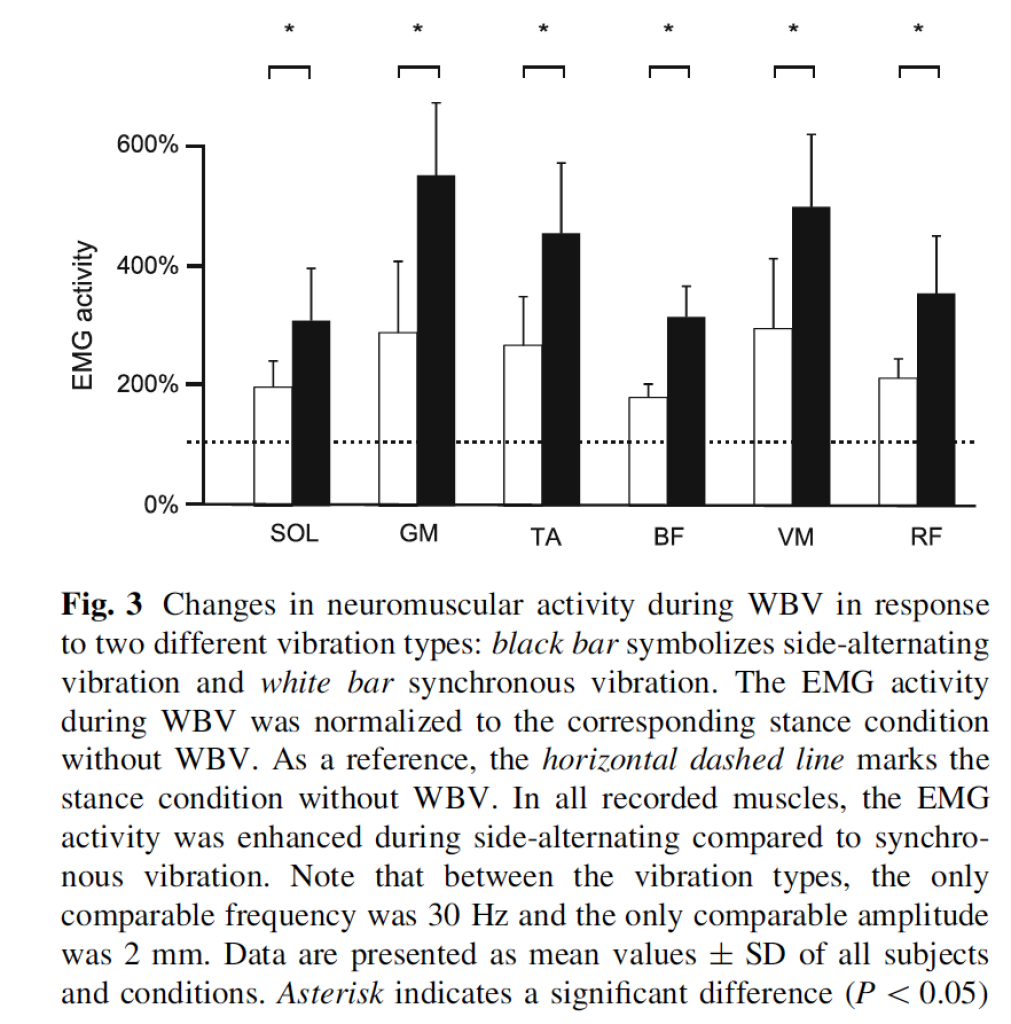
EMG Activity Galileo (black) vs Power Plate(white)
Source
Department of Physical Education and Sport, University of Seville, Seville, Spain.
OBJECTIVE: To determine whether a 12-week whole-body vibration (WBV) training program improved balance in participants with type 2 diabetes mellitus (T2DM).
DESIGN: Randomized controlled trial.
SETTING: Primary health care setting.
PARTICIPANTS: Participants with T2DM (N=50).
INTERVENTIONS: Participants were randomly allocated to either a WBV group (n=25), which performed a 12-week WBV-based exercise program on an oscillating platform (12-16Hz-4mm; 3 sessions/wk), or a usual-care control group (n=25).
MAIN OUTCOME MEASURES: Clinical and socio demographic variables were recorded at baseline. Static balance and dynamic balance were also assessed at baseline by measuring postural sway (measurement of center of pressure [COP] excursions in the anteroposterior and mediolateral directions) using a Wii Balance Board and the Timed Up and Go test.
RESULTS: Significant between-group differences in COP excursions with participants’ eyes closed were found with their feet apart and feet together. In addition, participants in the WBV group exhibited significantly lower COP excursions with their eyes closed after the intervention, while participants in the control group experienced a non significant deterioration in COP excursions (ie, greater excursion) with their eyes open (mediolateral axis). There was no significant difference in the Timed Up and Go test values post intervention.
CONCLUSIONS: WBV provides a safe and well-tolerated approach to improve balance in participants with T2DM. These findings may have important implications for falls prevention in those with T2DM in the primary health care setting.
Copyright © 2013 American Congress of Rehabilitation Medicine. Published by Elsevier Inc.
KEYWORDS: COP, Diabetes mellitus, Preventive therapy, Rehabilitation, T2DM, TUG, Timed Up and Go, Vibration, WBB, WBV, Wii Balance Board, center of pressure, type 2 diabetes mellitus, whole-body vibration
PMID: 23811317
Cologne Children’s Hospital, Jan 2013
E. Schoenau, C. Stark, O. Semler – Children’s Hospital, University of Cologne, Germany
Background: Rehabilitation of children with Cerebral Palsy (CP) aims to reduce sequelae and enhance function. Physiotherapy is a rehabilitative strategy for the treatment of patients with CP, but with little supporting evidence for the different treatment concepts. The Cologne Concept “Auf die Beine” combines Interval-Rehabilitation consisting of short and intensive in-patient stays with 6 months home-based whole body vibration training. “Auf die Beine” is a routine procedure supported by the German health care system. We are presenting the gross motor function results after 6 months of training and additional 6 months follow-up.
Design: Retrospective analysis of 356 children and adolescents
Participants and Setting: 356 children and adolescents diagnosed with CP were included in the retrospective analysis. Mean age was 8.9 years (SD 4.4) and GMFCS levels were 7.3% level I, 14.9% level II, 30.3% level III, 31.2% level IV and 7.6% level V. All patients completed 6 months of home based whole body vibration training, two blocks of intensive physiotherapy and the 12 month visit (6 months follow-up).
Methods: Gross motor function was assessed with the Gross Motor Function Measure (GMFM-66) total score after 6 and 12 (Follow-up) months and the GMFM-88-Goal-Dimensions after 6 months.
Results: GMFM-66-Totalscore improved by 2.9 points (Mean 3.35; p<0.001) after 6 months and by 0.2 points (Mean 0.63; p=0.033) after 6 months follow-up. Goal dimension A (lying) improved by 2.0% (Mean 3.8; p=0.001), B (sitting) by 3.3% (Mean 5.9; p<0.001), C (crawling) by 4.8% (Mean 6.7; p<0.001), D (standing) by 5.1% (Mean 8.0; p<0.001) and E (walking) by 2.8% (Median 4.6; p<0.001).
Conclusion: The Interval-Rehabilitation combined with home-based training shows a significant positive effect on gross motor function in patients with CP. The results could be sustained after 6 months follow-up. To our knowledge this is the first retrospective evaluation of a routine health care concept for children with mobility problems.
Effect of whole-body vibration on muscle strength and balance in diplegic cerebral palsy: a randomized controlled trial.
Am J Phys Med Rehabil. 2014 Feb;93(2):114-21
El-Shamy SM
Abstract
OBJECTIVE:
The purpose of this study was to investigate the effects of whole-body vibration training on muscle strength and balance in children with diplegic cerebral palsy.
DESIGN:
Fifteen children were assigned to the experimental group, which received whole-body vibration training (9 mins per day, 5 days per week). Another 15 were assigned to the control group, which participated in a traditional physical therapy exercise program for 3 successive months. Baseline and posttreatment assessments were performed using the Biodex isokinetic dynamometer to evaluate the knee extensors peak torque at 60 degrees per second and 90 degrees per second and using the Biodex balance system to evaluate stability index.
RESULTS:
The children in the experimental group showed a significant improvement when compared with those in the control group (P < 0.001). The peak torque at 60 degrees per second and 90 degrees per second after treatment was 28.8 ± 0.45 and 47.5 ± 0.7 N · m and 30.9 ± 0.68 and 54.2 ± 1.7 N · m for the control and the experimental group, respectively. The overall stability index after treatment was 2.75 and 2.2 for the control group and the experimental group, respectively.
CONCLUSIONS:
Whole-body vibration training may be a useful tool for improving muscle strength and balance in children with diplegic cerebral palsy.
PMID: 24434887 [PubMed – indexed for MEDLINE]
Clinical Rehabilitation February 14, 2013
Objective: To evaluate ambulatory function and leg muscle thickness after whole body vibration training in children with cerebral palsy.
Design: A block randomized controlled trial with two groups.
Setting: Physical therapy department laboratory.
Subjects: A total of 30 (15 experimental, mean (SD) age 10.0 (2.26) years and 15 control, 9.6 (2.58)) children with cerebral palsy, 15 males and 15 females.
Interventions: The experimental group underwent whole body vibration training combined with conventional physical therapy training; the control group underwent conventional physical therapy training three days a week for eight weeks respectively.
Main outcome measures: Three-dimensional gait analyses and ultrasonographic imaging of the leg muscles were measured at pre- and post-test of intervention for eight weeks.
Results: Whole body vibration training resulted in significantly better gait speed (P = 0.001, from 0.37 (0.04) m/s to 0.48 (0.06)), stride length (P = 0.001, from 0.38 (0.18) m to 0.48 (0.18)) and cycle time (P = 0.001, from 0.85 (0.48) s to 0.58 (0.38)) in the experimental group compared with that in the control group. The ankle angle (P = 0.019, from 7.30 (4.02) degree to 13.58 (8.79)) also showed a remarkable increase in the experimental group, but not the hip (P = 0.321) and knee angle (P = 0.102). The thicknesses of the tibialis anterior (P = 0.001, 0.48 (0.08) mm to 0.63 (0.10)) and soleus (P = 0.001, 0.45 (0.04) mm to 0.63 (0.12)) muscles were significantly higher in the experimental group than in the control group. However, no significant effect was observed in the thickness of the gastrocnemius muscle (P = 0.645).
Exercise, Health and Performance, Faculty Research Group, Faculty of Health Sciences, University of Sydney, Australia.
To examine the effects of whole body vibration (WBV) exposure on muscle function in children with Cystic Fibrosis (CF). Non-randomised controlled cross-over trial.
The setting was home-based WBV exposure. The participants were children (8 – 15 years) with CF (n = 7).
participants served as their own controls for the first four weeks (usual care), then underwent four weeks of parentally-supervised home-based WBV exposure followed by four weeks washout (usual care). The WBV exposure consisted of 20 – 30 minutes of intermittent (1 min vibration:1 min rest) exposure on a Galileo platform (20 – 22Hz, 1 mm amplitude) 3 days/week. The primary outcome measures of absolute and relative lower body (leg extension (LE), leg press (LP)), upper body (chess press (CP)) strength and power, and power were measured at baseline, and weeks 4, 8 and 12. Secondary exploratory outcomes were cardiorespiratory fitness, pulmonary function and health-related quality of life.
Six participants completed the training without adverse events. Muscle function changes following WBV exposure were not statistically significant. However, moderate-to-large relative effect sizes (ES) favouring WBV were evident for leg extension strength (ES = 0.66 (-0.50, 1.82)), LP relative strength (ES = 0.92 (-0.27, 2.11)), leg press peak power (ES = 0.78 (-0.50, 2.07)) and CMJ height (ES = 0.60 (-0.56 to 1.76)).
The results from this first controlled trial indicate that WBV may be a potentially effective exercise modality to safely increase leg strength and explosive power in children with CF. Potentially clinically relevant changes support continued investigation of the efficacy, mechanism and feasibility of this intervention in future large-scale studies.
Children, Cystic Fibrosis, Muscle function, Muscle power, Vibration
J Musculoskelet Neuronal Interact. 2013 Mar;13(1):13-8.
Department of Orthopedics, Institute of Clinical Sciences, Sahlgrenska University Hospital/Östra, Sahlgrenska Academy at the University of Gothenburg, Göteborg, Sweden. ann-charlott.soderpalm@vgregion.se
To study the tolerability of whole body vibration (WBV) exercise in patients with Duchenne muscular dystrophy (DMD) and its effects on muscle and bone.
WBV was performed two to three times a week for three months. Motor function, muscle strength, bone mass and biochemical markers of bone and mineral metabolism were analyzed before and after the WBV period at 0, 3, 6 and 12 months.
Six ambulatory patients with DMD aged 5.7-12.5 years completed the study. No changes in creatine kinase activity were found, indicating that the WBV exercise did not further damage the skeletal muscle. No significant changes in bone mass, muscle strength or bone markers were found. However, there was a non-significant trend for the bone formation marker, bone-specific alkaline phosphate, to increase from a mean of 59 U/L to 73 U/L after three months of WBV. The bone formation marker levels returned to baseline three months after discontinuing WBV and were still at that level after nine months.
WBV therapy appears to be safe and well tolerated among ambulatory DMD patients. The potential benefits of WBV on bone and muscle in DMD remain to be elucidated.
PMID: 23445910
Vibration therapy tolerated in children with Duchenne muscular dystrophy: a pilot study.
Pediatr Neurol. 2014 Jul;51(1):126-9
Myers KA1, Ramage B2, Khan A3, Mah JK4.
Abstract
BACKGROUND:
Duchenne muscular dystrophy is an X-linked recessive muscular dystrophy. Clinical management primarily involves rehabilitation strategies aimed at preserving functional mobility as long as possible. Side-alternating vibration therapy is a rehabilitation intervention that has shown promise in a number of different neuromuscular disorders, and has the potential to preserve strength, functional mobility, and bone mass. There has been little research regarding the tolerance to side-alternating vibration therapy in muscle diseases such as Duchenne muscular dystrophy.
METHODS:
Four patients were recruited for a pilot study assessing the safety and tolerance of side-alternating vibration therapy in individuals with Duchenne muscular dystrophy. All patients participated in a 4-week training period involving side-alternating vibration therapy sessions three times per week. Serum creatine kinase was measured, and adverse effects reviewed at each session with functional mobility assessed before and after the training period.
RESULTS:
All patients tolerated the training protocol well, and there were no major changes in functional mobility. One patient had a transient increase in creatine kinase during the study; however, levels of this enzyme were stable overall when comparing the pretraining and posttraining values. Some patients reported subjective improvement during the training period.
CONCLUSIONS:
Side-alternating vibration therapy is well tolerated in children with Duchenne muscular dystrophy and may have potential to improve or maintain functional mobility and strength in these patients.
Copyright © 2014 Elsevier Inc. All rights reserved.
KEYWORDS:
Duchenne muscular dystrophy; rehabilitation; safety; side-alternating vibration therapy; whole-body vibration therapy
PMID: 24830767 [PubMed – indexed for MEDLINE]
Phys Rehab Kur Med, 2003; 13: 286-290
Crevenna R, Fialka-Moser V, Rödler S, Keilani M, Zöch C, Nuhr M, Quittan M, Wolzt M
Department of Physical Medicine and Rehabilitation, Department of Cardiothoracic Surgery, Department of Clinical Pharmacology, Department of Cardiology, Vienna University, Vienna, Austria
Purpose: The benefits of whole-body vibration exercise (WBV) have not yet been recognized in heart transplant recipients although these patients often show a severe loss in skeletal muscle strength and bone mineral density over time. At present, WBV is not generally recommended for rehabilitation of transplant patients. The purpose of this study was to document the safety, cardiovascular responses and metabolic changes to WBV in heart transplant patients.
Material and Methods: 14 male clinically stable heart transplant recipients were included in this study. The subjects were exposed to one set of whole-body vibration using the Galileo 2000 device. Heart rate, systolic and diastolic blood pressure, blood lactate concentration and the Borg scale were used to determine objective and subjective exertion during WBV.
Results: In every patient WBV was terminated due to muscular fatigue. The mean duration of exercise was 248 seconds (range, 51 – 607 seconds). Heart rate, systolic and diastolic blood pressure, lactate concentrations and the Borg score increased during WBV to levels achieved during aerobic exercise. No patient experienced adverse events.
Conclusion: The results of this pilot study indicate that WBV is feasible and safe in heart transplant recipients. The cardiovascular and metabolic response of an acute bout of WBV is similar to that of standard aerobic exercise.
Whole body vibration training is a new and complimentary exercise modality for endurance and strength training in patients with chronic obstructive pulmonary heart disease (COPD) and provides safe exercise to improve muscle power, exercise tolerance, reduce symptoms of dyspnea, and increase HRQL.
Galileo’s side-alternating stimulation is a fast and efficient muscle tool for people with neurological diseases to improve postural control and for patients with osteoporosis to enhance bone mineral density. 1,2
In healthy subjects it has been shown that performing resistance training on Galileo induces greater neuromuscular and hormonal responses than resistance training alone by providing a more intense stimulus. 3
Major effects from peer reviewed studies are:
1. Zha DS, Zhu QA, Pei WW, Zheng JC, Wu SH, Xu ZX, et al. Does whole-body vibration with alternative tilting increase bone mineral density and change bone metabolism in senior people? Aging Clin Exp Res 2011.
2. Merkert J, Butz S, Nieczaj R, Steinhagen-Thiessen E, Eckardt R. Combined whole body vibration and balance training using vibrosphere(R): improvement of trunk stability, muscle tone, and postural control in stroke patients during early geriatric rehabilitation. Z Gerontol Geriatr 2011.
3. Ronnestad BR. Comparing the performance-enhancing effects of squats on a vibration platform with conventional squats in recreationally resistance-trained men. J Strength Cond Res 2004;18(4):839e45.
4. Nishihira Y, Iwasaki TAH. Effects of whole body vibration stimulus and voluntary contraction on motorneuron pool. Adv Exerc Sports Physiol 2002;8(4):83e6.
5. Bosco C, Colli R, Introini E, Cardinale M, Tsarpela O, Madella A, et al. Adaptive responses of human skeletal muscle to vibration exposure. Clin Physiol 1999;19(2):183e7.
6. Butcher SJ, Meshke JM, Sheppard MS. Reductions in functional balance, coordination, and mobility measures among patients with stable chronic obstructive pulmonary disease. J Cardiopulm Rehabil 2004;24(4):274e80.
Institute of Sport Sciences, Johann Wolfgang Goethe-University, Frankfurt/Main, Germany. turbanski@sport.uni-frankfurt.de
We investigated spontaneous effects of random whole-body vibration (rWBV) on postural control in Parkinsonian subjects. Effects were examined in biomechanical tests from a total of 52 patients divided equally into one experimental and one control group. Postural control was tested pre- and post-treatment in two standardized conditions (narrow standing and tandem standing).
The intervention was based on rWBV (ŷ: 3 mm, f: 6 Hz/sec) consisting of 5 series lasting 60 seconds each.
The main findings from this study were that:
PMID: 16392539